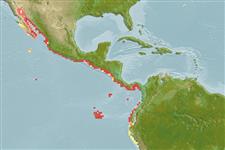Environment: milieu / climate zone / depth range / distribution range
Écologie
marin récifal; profondeur 10 - 60 m (Ref. 91172). Tropical; 33°N - 12°S, 115°W - 78°W (Ref. 55)
Eastern Pacific: Mexico to Peru.
Length at first maturity / Taille / Poids / Âge
Maturity: Lm 26.4, range 17 - 18 cm
Max length : 105 cm TL mâle / non sexé; (Ref. 106806); poids max. publié: 1.3 kg (Ref. 40637)
Description synthétique
Clés d'identification | Morphologie | Morphométrie
Épines dorsales (Total) : 10; Rayons mous dorsaux (Total) : 12 - 13; Épines anales: 3; Rayons mous anaux: 8. Preopercular notch and knob weak. Scale rows on back rising obliquely above the lateral line. Pale crimson on side, often with silvery sheen of horizontal rows of bluish spots; belly golden yellow. Head with bluish spots and irregular broken lines, especially across cheek. A large blackish blotch on the upper back below the posterior of the dorsal spines.
Adults are found over hard bottoms in inshore reef areas. Generally solitary or in small groups but may occasionally form big schools (Ref. 9313). Juveniles inhabit estuaries and mouths of rivers (Ref. 9313). Carnivorous, feed on invertebrates and fish (Ref. 9313). Marketed fresh or frozen (Ref. 9313).
Allen, G.R., 1985. FAO Species Catalogue. Vol. 6. Snappers of the world. An annotated and illustrated catalogue of lutjanid species known to date. FAO Fish. Synop. 125(6):208 p. Rome: FAO. (Ref. 55)
Statut dans la liste rouge de l'IUCN (Ref. 130435)
Menace pour l'homme
Harmless
Utilisations par l'homme
Pêcheries: commercial; pêche sportive: oui
Outils
Articles particuliers
Télécharger en XML
Sources Internet
Estimates based on models
Preferred temperature (Ref.
123201): 22.3 - 29.1, mean 26.2 °C (based on 214 cells).
Phylogenetic diversity index (Ref.
82804): PD
50 = 0.5000 [Uniqueness, from 0.5 = low to 2.0 = high].
Bayesian length-weight: a=0.01349 (0.00844 - 0.02157), b=2.91 (2.78 - 3.04), in cm total length, based on LWR estimates for this species & Genus-body shape (Ref.
93245).
Niveau trophique (Ref.
69278): 4.0 ±0.2 se; based on diet studies.
Résilience (Ref.
120179): Milieu, temps minimum de doublement de population : 1,4 à 4,4 années (K = 0.19; Fec = 66,400).
Prior r = 0.57, 95% CL = 0.37 - 0.85, Based on 1 data-limited stock assessment.
Fishing Vulnerability (Ref.
59153): Low to moderate vulnerability (35 of 100).
Nutrients (Ref.
124155): Calcium = 28.4 [17.6, 41.8] mg/100g; Iron = 0.327 [0.204, 0.502] mg/100g; Protein = 18.8 [17.3, 20.2] %; Omega3 = 0.127 [0.086, 0.183] g/100g; Selenium = 71.2 [46.4, 111.1] μg/100g; VitaminA = 88 [17, 326] μg/100g; Zinc = 0.362 [0.282, 0.513] mg/100g (wet weight);
